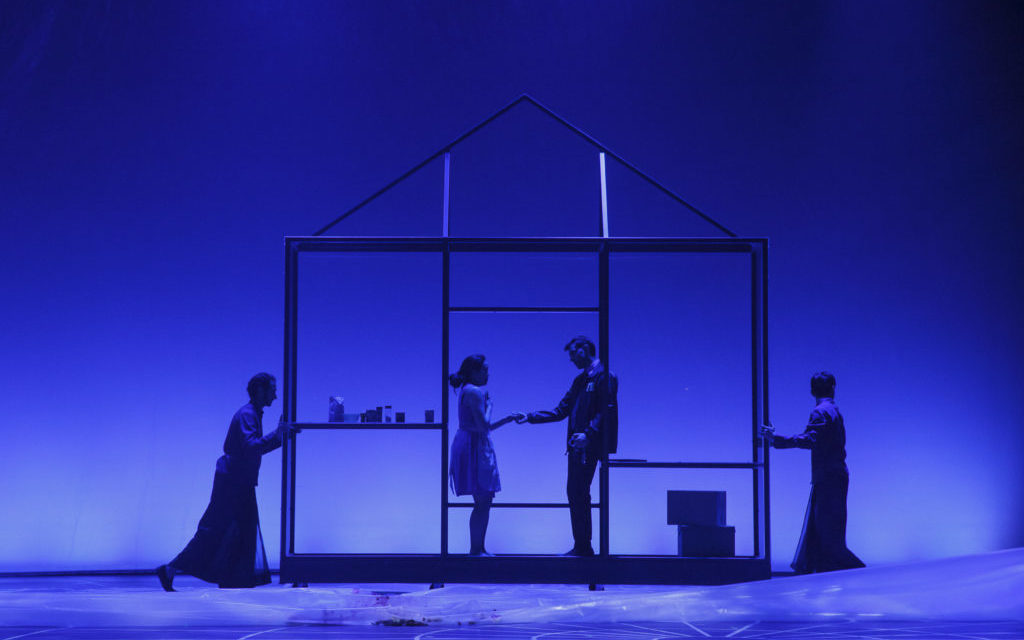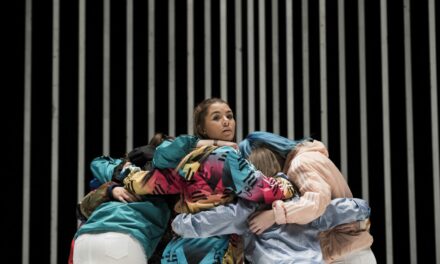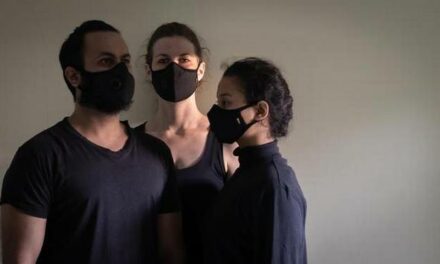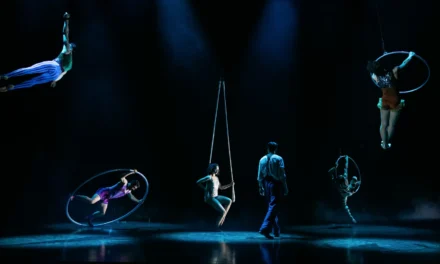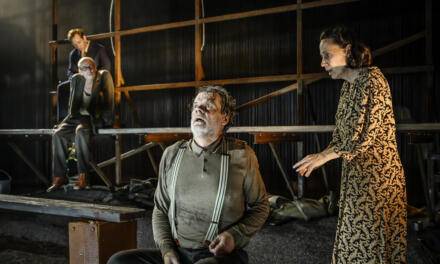carried away on the crest of a wave By David Yee, Directed by Kim Collier. A NAC English Theatre Production run until April 1.
Again and again, the stage of the NAC Theatre takes on an eerie beauty—one that is often not quite of this world yet stays anchored to a heartbreaking reality.
That reality is the 2004 earthquake and tsunami that killed a quarter of a million people in the area of the Indian ocean. A key thread running through David Yee’s compelling play—carried away on the crest of a wave—suggests not just aftershocks around the world but an existential crisis that occurred in the lives of those left behind to mourn the loss of those they cared about. It’s also about a loss of faith—in one key episode, a matter-of-fact Muslim engineer demolishes a Roman Catholic priest’s fervent belief that it was an act of God that saved his basilica and congregation from destruction. Mythology also surfaces: is it really pure fantasy to suggest, as one character does, that Planet Earth sits on the back of a turtle?
Yee is dealing with big issues here, yet by declining to capitalize the title of his play, he seems to be stressing the presence of larger cosmic forces that make our own efforts to contain them seem puny.
Classical drama grasped the importance of metaphor. So does Yee as he seeks to give utterance to the shimmering, elusive poetry of life and death. And so does director Kim Collier whose spellbinding production often assumes the texture of a dreamscape.
So much is being achieved in this production with so little. Of the nine dramatic snapshots on offer in this piece, perhaps the most affecting concerns an orphaned child alone in an airport as she waits to travel to a new and uncertain life. We also meet a stranger, also alone in the world, who has been there for her when she needed him during the horrors of the tsunami. And there’s the uncle who arrives to collect her: his identity leads to an ironic coincidence which in turn reiterates the playwright’s preoccupation with the way humans may interconnect.
It’s a touching moment thanks to the performances of Clarissa Lauzon as a child who has lost her immediate family in the disaster and John Ng and Jonathan Tan as the two men who offer succour. But its dramatic power is enhanced by its “look.” Yet there’s not much there. A simple bench on which a child can sit. A digital flight board blinking mysteriously in the distance. A disembodied voice announcing flight departures and arrivals. A massive yawning emptiness to remind us that an airport can be a soulless place. This is minimalist theatre involving the vision of a director who knows that less can equal more and who is working in harmony with the spare integrity of Camellia Koo’s set designs, the discreet lighting of Gerald King and the soundscape of Brian Linds.
The appropriate props are there when needed. But look at that illuminated notice board again, or those unpacked containers in a Salt Lake City flat, or that simple dwelling surrounded by treacherous waters, waters created here by billowing plastics, or that hazy image of a couple in loveless ecstasy—all whispering of a Beckettian nothingness.
Yee’s play, at its best a work of imaginative vigour and magical language, was the winner of the 2015 Governor General’s Award for drama. Yet how effectively could it deliver without the kind of brilliant creative team and responsive cast assembled for this production? The question is a fair one: it’s doubtful, for example, if Phantom Of The Opera’s extraordinary success would have been possible without the remarkable vision of director Hal Prince.
In the case of carried away not every moment of the script is of equal value. Take the scene in which a character from on high descends a rope to converse with a man who has confined himself to a deep hole for nearly five years: it’s notable more for its acrobatics than for what they’re saying to each other—indeed the business about chicken salad sandwiches is merely irritating. And then there’s the final scene in which John Ng, a good actor, gamely tackles an overlong speech about the necessity for interdependence in human survival. It’s not Ng’s fault that we’re more drawn psychologically to the production’s sombre visual landscape and to the hunched solitary figure squatting beside him on the ground than we are to the message the play is earnestly striving to convey. So yes, it’s fair to suggest that the calibre of this production also provides a lifeline for problematic moments in the writing.
The important thing is that so much remains that is good—and it’s beautifully served by an excellent cast responsive to the material’s shifting tides.
David Yee is a humane playwright but his anger does spark one scathing portrait of a Toronto disc jockey (an unsettling Kayvon Khoshkam) who cynically mocks disaster-relief efforts in an attempt to bolster his own trendy on-air image. Still, it’s Yee’s venture into private emotions that have the greatest resonance. A bereaved mother, back home in Salt Lake City, pathetically attempts to pass off another’s child as the son she lost to the tsunami. A husband in anguish over the loss of his wife seeks solace and ultimately a form of devastating closure from a prostitute: here Ryan Hollyman’s unleashed grief is palpably painful and, as the hooker, Andrea Yu’s use of silence and body language is devastating. At its best, the NAC’s current production is a memorable affirmation of theatre as a sensory experience.
This article originally appeared in Capital Critics’ Circle on March 27, 2018, and has been reposted with permission.
This post was written by the author in their personal capacity.The opinions expressed in this article are the author’s own and do not reflect the view of The Theatre Times, their staff or collaborators.
This post was written by Jamie Portman.
The views expressed here belong to the author and do not necessarily reflect our views and opinions.

